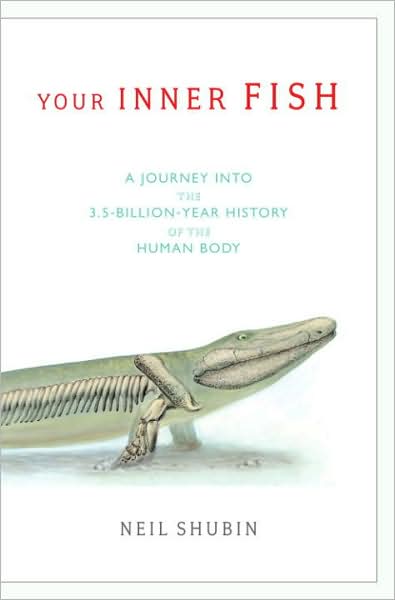Vintage Books, 2009
 Some books should be read sitting up; others are best read supine. Some are daytime books; others bedtime reading. Books addressing such topics as paleontology and comparative anatomy are almost always upright, daylight books. But I’ve been reading Your Inner Fish in bed at night. While its subject warrants the brain-thrust-forward pose of the library desk—the subtitle is A Journey into the 3.5-Billion-Year History of the Human Body—Shubin’s lay-friendly voice, his humility and humor, and his relish of zoological ironies and evolutionary jokes, all invite the reader to recline. Science becomes the progenitor of dreams.
Some books should be read sitting up; others are best read supine. Some are daytime books; others bedtime reading. Books addressing such topics as paleontology and comparative anatomy are almost always upright, daylight books. But I’ve been reading Your Inner Fish in bed at night. While its subject warrants the brain-thrust-forward pose of the library desk—the subtitle is A Journey into the 3.5-Billion-Year History of the Human Body—Shubin’s lay-friendly voice, his humility and humor, and his relish of zoological ironies and evolutionary jokes, all invite the reader to recline. Science becomes the progenitor of dreams.
Shubin’s book arose, he writes, from his experiences as a paleontologist teaching anatomy to medical students. He makes sense of our complex bodies by tracing the “profound connection” between the first fish who came to land 3.75 billion years ago and today’s human body. It was Shubin’s research team that, in Ellesmere Island in 2004, discovered this “missing link” fish, dubbed Tiktaalik, the Inuktitut (Innuit) name for “large freshwater fish.” As we go back in geological time, we find human bodies in embryo. Shubin traces, for example, how the fins of fish (and of human embryos) evolve first into specialized fins and then into limbs.
Our “inner fish” resides not only in our skeletal (as well as nervous, digestive, and circulatory) structures, but also in the “ancient genes” that give them direction. Our DNA bears very old and nonhuman imprints. George W. Bush once warned about “human-animal hybrids”—but, as it turns out, we’re that already. Shubin’s inner fish story also explains some of the paradoxes of the human genome, such as why we have more “odor genes” than we need. This excess baggage in our DNA “is a silent witness to our past.”
Bedtime reading morphs into dreams, as I sink into my “mud bed” (a modified water bed), which my partner and I dub, “the Womb.” I feel Your Inner Fish flop onto my chest as my closing eyes become the simple pits in the jellyfish’s epidermis. My inner ears revert to the neuromasts on the sides of the shark’s head, giving me information about the changes in water flow. My arms turn to fins as I swim, gills fanning, back to the beginning.
—
Deborah Thompson is associate professor in English at Colorado State University. Her nonfiction has appeared in Alligator Juniper, Fourth Genre, Western Humanities Review, and CALYX. In the nonfiction category, she has won the 2008 Missouri Review Editor’s Prize, the 2008 Florida Review Editor’s Prize, and the 2009 Iowa Review Editor’s Prize.
